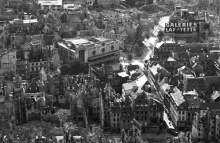Detective work uncovers hidden secrets in the Aerial Reconnaissance Archive (TARA)
Aerial photographs of prisoners in the central courtyard of Colditz high security prison and POWs that worked on the infamous bridge over the River Kwai, along with images taken during the post D-Day battle for Normandy and the Suez Crisis of 1956, are now available to view online for the first time.
The photographs were discovered as part of a painstaking process of cataloguing and digitising TARA imagery for the newly launched National Collection of Aerial Photography website.
Other never before seen images include a slave labour camp near Mainz, Germany; a test launch site for the Nazi Vengeance - or V - missiles at Peenemunde; a 1952 shot of a viaduct on the longest national motorway in Europe, the Bundesautobahn 7, in Hessen; and a 1944 RAF photograph of a series of giant bomb craters running through the town of Saumur in Maine-et-Loire, France.
While TARA is made up of thousands of microfilm rolls containing millions of individual images, only a small percentage has so far been catalogued and digitised. Discovering exactly what the films contain is an ongoing task requiring in-depth detective work. The aerial archive team use squadron records to link reconnaissance flights to major events in time, and, by identifying geographic references in archive photography, they can then match historic imagery to locations in the modern landscape - some of which have changed beyond recognition since the Second World War.
Manager of The National Collection of Aerial Photography, Allan Williams said:
We are uncovering new images every day, but to locate photographs with such powerful links to major events is incredibly exciting. Without doubt, we'll continue to make amazing discoveries. The amount of reconnaissance photography taken during and since the Second World War is astonishing, and its role in expanding our knowledge and understanding of twentieth century history is critical. It's providing us quite literally with a new perspective on historical events - from the air.
The launch of the new website is integral to the RCAHMS conservation plan for TARA, which includes further research and progressive digitisation for display online, as well as storing and preserving the original materials for public access.


